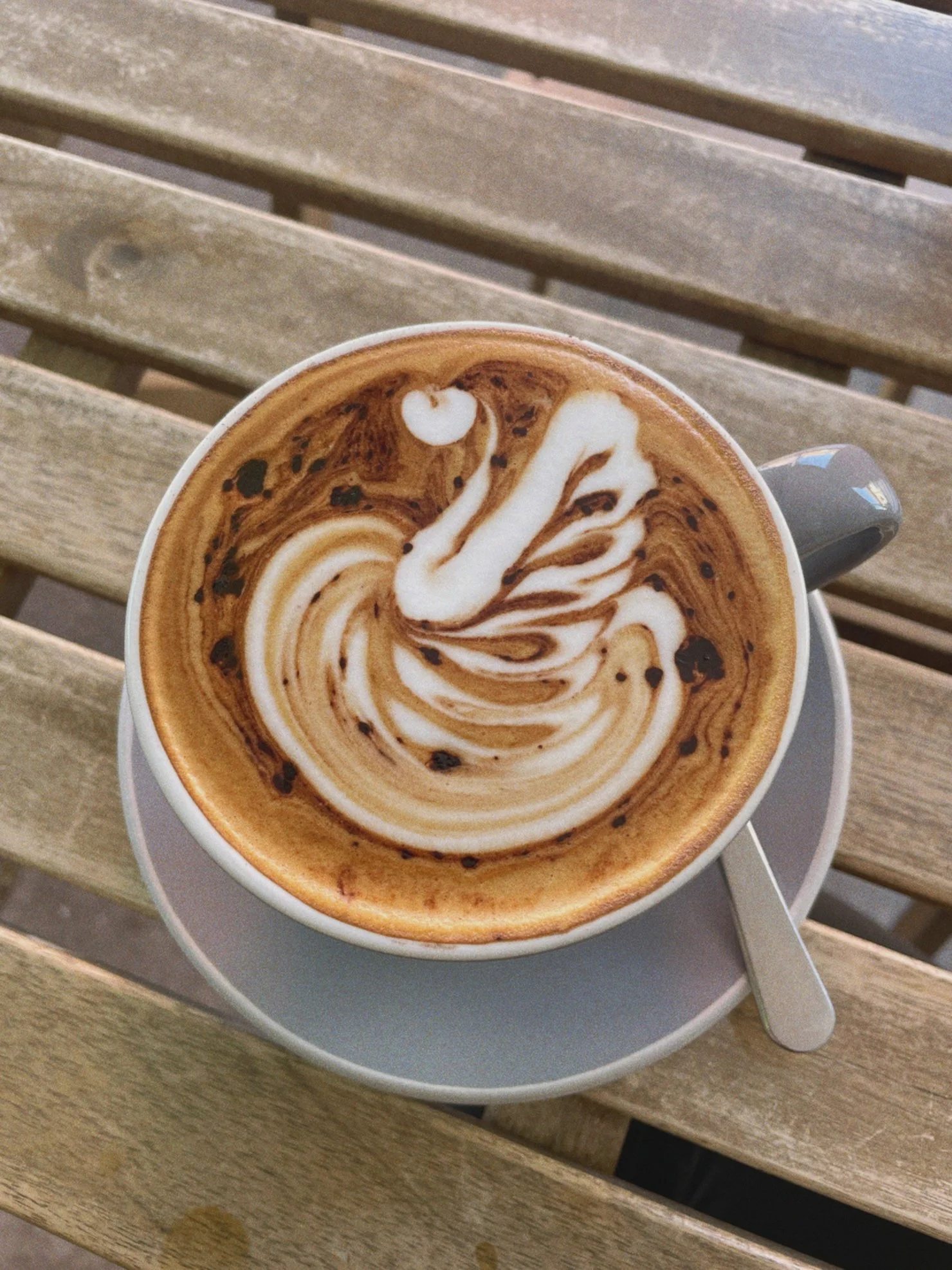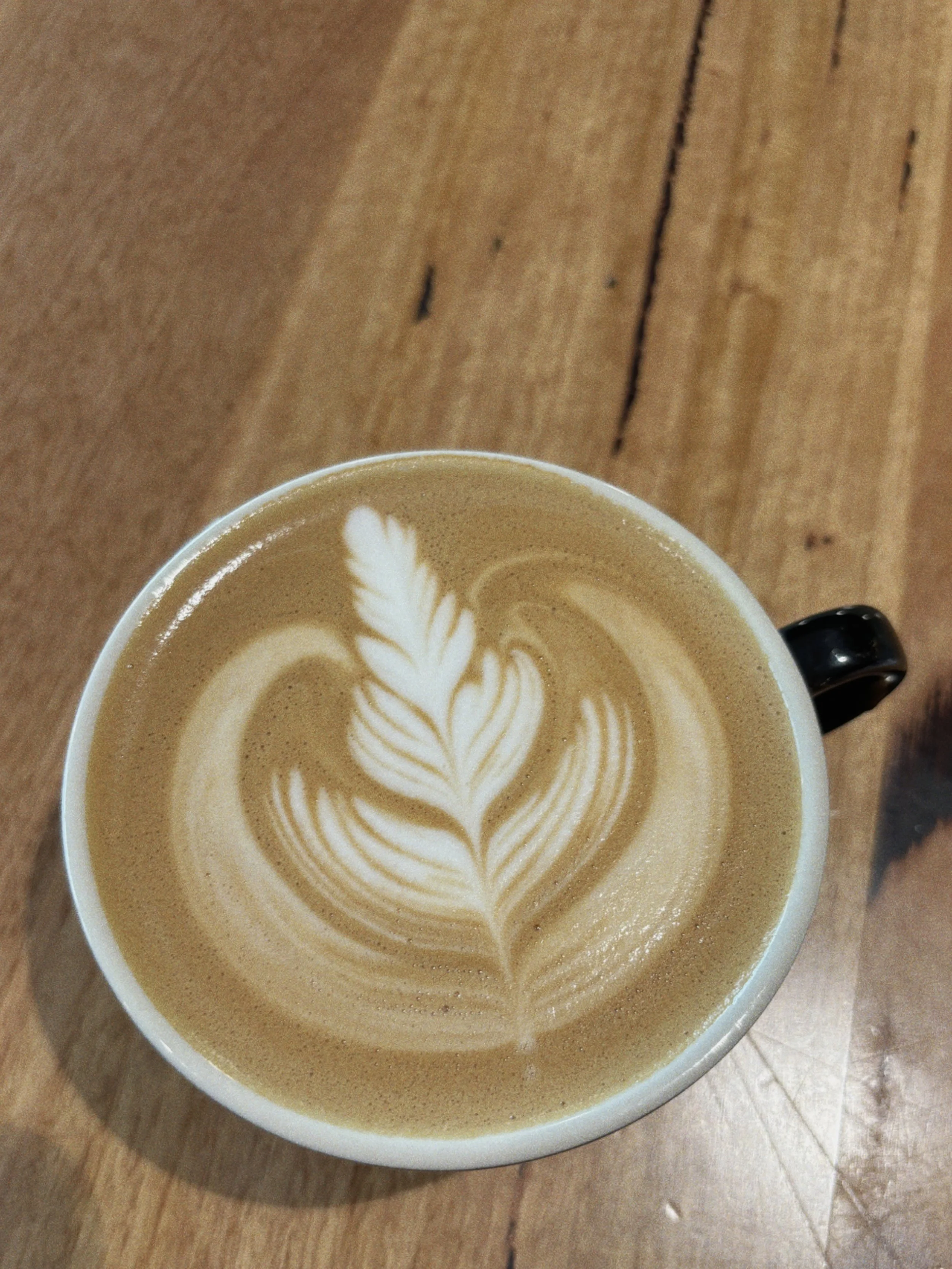Why I expect beautiful latte art (and why you should too)
So in love with this tortie silverware at Kin, Teneriffe, Brisbane
You’ve got to admit, we all love the surprise of the design on the top of our coffee. It’s the little things in life, hey? I’m the same, I’ve got a dedicated folder in my camera roll just for beautiful coffees enjoyed over the years. From the untrained eye, you wouldn’t think there’s much to it other than being a gimmick to put on your instagram story, but the meaning of latte art on your morning coffee goes so much further.
I can’t talk about coffee without mentioning where I learnt a great deal of what I know, Australia. Of course you can get a good and bad cup of coffee in any country, it’s a subjective drink when it comes to taste and undertones, but my appreciation for the art of coffee blossomed on the other side of the world over 2 years. I worked in cafes in Brisbane, but tasted coffee practically every morning on the road around the country, and I can attest to latte art equalling a better tasting coffee.
I spoke to Rohan Kirk, coffee aficionado of Golden Brown Coffee on Instagram and TikTok, to get some further insight into the process of coffee making and how latte art relies on this, his thoughts are dotted throughout.
Process
Let’s start with the technicalities. Decent latte art means decent skills behind the espresso machine. The two elements of a coffee are the espresso and the heated milk, both need to be treated with skill to work together to create great latte art. Baristas make steaming milk look easy, but there is such a fine art to heating, aerating and texturising the milk. Without these three steps of steaming milk understood by the barista, the milk will not be nice to drink, let alone look at.
Rohan makes the point “you can’t get good latte art without well textured milk… if you let in too much air or not enough air the foam won’t be the right consistency for latte art, if it’s too thin it runs around the cup too much and if it’s too thick it becomes too stiff and impossible to pour latte art”. A quick point to understand when Rohan says it ‘runs around the cup’ - picture an oil spill on a puddle, where lines between colours are jagged and irregular. This is the same with mixing thin milk and espresso, the consistencies aren’t creamy or stable enough to hold a solid design, so lines bleed into one another.
Steaming milk of course brings it to temperature. Another important element of the process; making sure the first sip is enjoyable, doesn’t burn your tongue and keeps a smooth taste to the coffee. Severely overheated milk will split in the jug and hold too many bubbles, making it practically impossible to pour something pretty with. Underheated, and it won’t be aerated or texturised enough to have a ‘creamy’ consistency to pour and hold a design.
It’s a fine art to balance, especially with less stable alternative milks, so seeing a smooth rippled design in your cup means you can trust the milk has been handled properly and with care by the barista.
Rich Crema
There’s two colours in latte art - the actual design, a bright white from velvety milk, and its rich caramel backdrop, often overlooked. Pulled espresso has a foamy golden top called the ‘crema’, named so for its creamy orange froth that comes from the aeration during extraction. This golden portion is what baristas pour their art into. Regarding the crema, Rohan explained, “coffee should have a good crema in order to be able to pour good latte art… a good crema means fresh beans and well extracted coffee. If you have old beans, you’re not going to get a good crema and if you have badly extracted coffee you’re not going to get a good crema either”.
Seeing that rich umber wrapped around your latte art is a great indicator of the quality and extraction of the espresso that makes up your coffee.
Seeing a design in the crema is also a show of care from the barista. Just dumping the milk into the cup will sink that crema and make a very boring cup indeed. A gentle pour from a height to start, swirling a equal amounts of espresso and steamed milk together, sets the base or ‘canvas’, as the change in consistency allows for the art to settle onto the espresso, creating the design.
Rohan finds importance here too, with baristas swirling the milk and coffee to be fully homogenous at the start of their pour “to make they’re blended perfectly for…a really nice taste and mouth feel”. All of these elements come together to explain that well executed coffee making results in well executed latte art.
A clean cup
It goes against everything in me to serve a coffee that doesn’t have the right ratio of froth, a beautiful design on top and certainly not with any drips down the side. The layer of froth that the latte art is set into caps off the drink; the cup is filled right to the top, with the liquid only coming to a finger’s width from the rim.
As your waiter walks to your table, maybe in a bit of a rush, swaying the cup won’t spill any coffee if there’s a good ratio of foam. Whereas if the coffee is lacking latte art due to froth being thin on the ground, the coffee is much less stable when filled and, chances are, your saucer will be swimming in liquid - not so pretty.
Aesthetics and food
Attraction to well presented food and drink is engrained in us, “we eat with our eyes” was Rohan’s final point in his voice note to me. Before we even put anything into our mouth, we’ve decided whether we’re going to like it or not based on its presentation, colour and texture. In the context of coffee, I’ve detailed this with the texture of the milk and the richness of the crema. However, this all comes together with the basic understanding that presentation is key, its what excites the brain and readies it for a great tasting experience.
Nicola Perullo makes a great point in his book Taste as Experience; ‘acquolina in bocca’, which we know as ‘mouth-watering’; stimulating the other senses can have an effect on us, before the food or drink even touches our lips. Baristas must take into account the undoubted link between visual and tasting experiences, and reflect that in the presentation of the coffees they serve. Latte art has been developed with this in mind, using the texture of steamed milk in a creative way to literally pour elegance into a humble cup of espresso.
Poured by yours truly
A final note, is the gaining influence of photo sharing in the success of a business in the past decade. Instagram and TikTok are saturated with food and drink based content, making quality over quantity the goal here. To be noticed on these ever growing channels, hospitality businesses rely on their products to look as good as they can to earn attention and even virality. I’m sure you can think of restaurants, cafes or products in posts you’ve saved or sent to friends as something you want to try because of their presentation and how good it would look on your Insta.
Erewhon smoothies, strawberry matchas, dalgona coffees, Starbucks’ pink drink and so many more have had their time in the spotlight, which in turn brought custom to the industry. Businesses have seen the power in organic marketing through social media, and understandably strive to present their food and drinks as interesting or compelling enough to get posted and tagged.
So, is it fair to be disappointed without?
With these elements combined, latte art really does serve a purpose other than being a silly little heart on your double shot skim flat white with a sugar. Not only is the art in your cup an indicator of a well made coffee, but it is also a sign from the barista or cafe that they care about your tasting and dining experience. On an industry level, latte art works as an advertisement for business, perpetuating a culture of good coffee making. A cycle that relies upon the humble rosetta.




